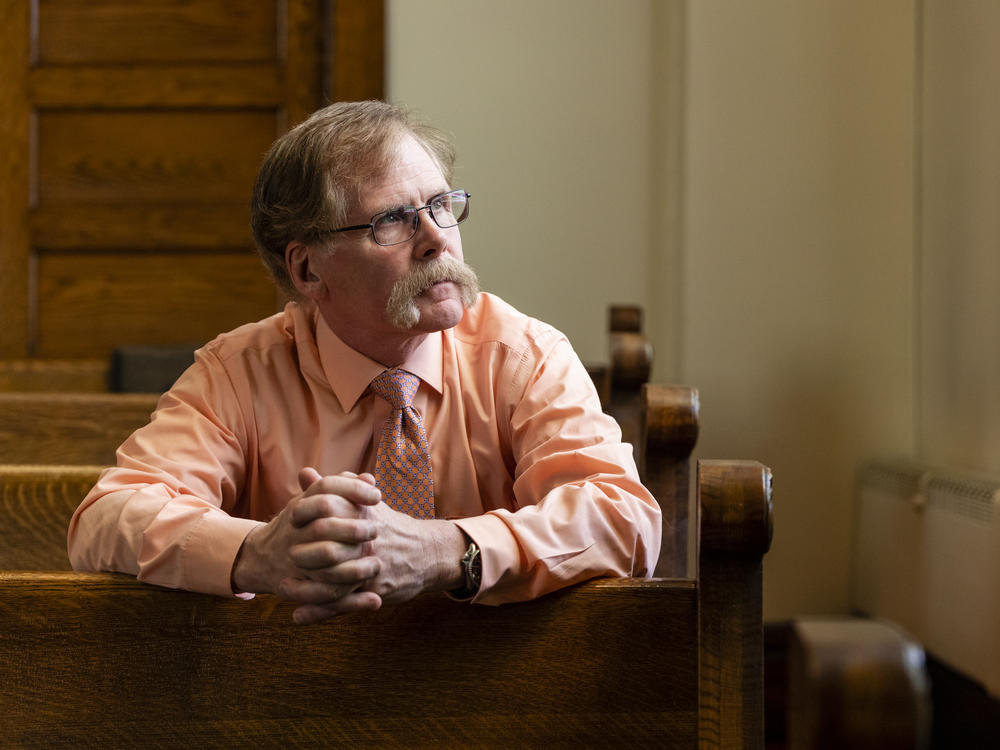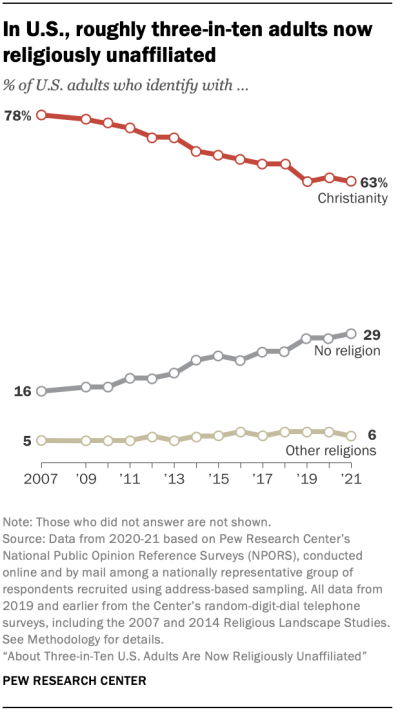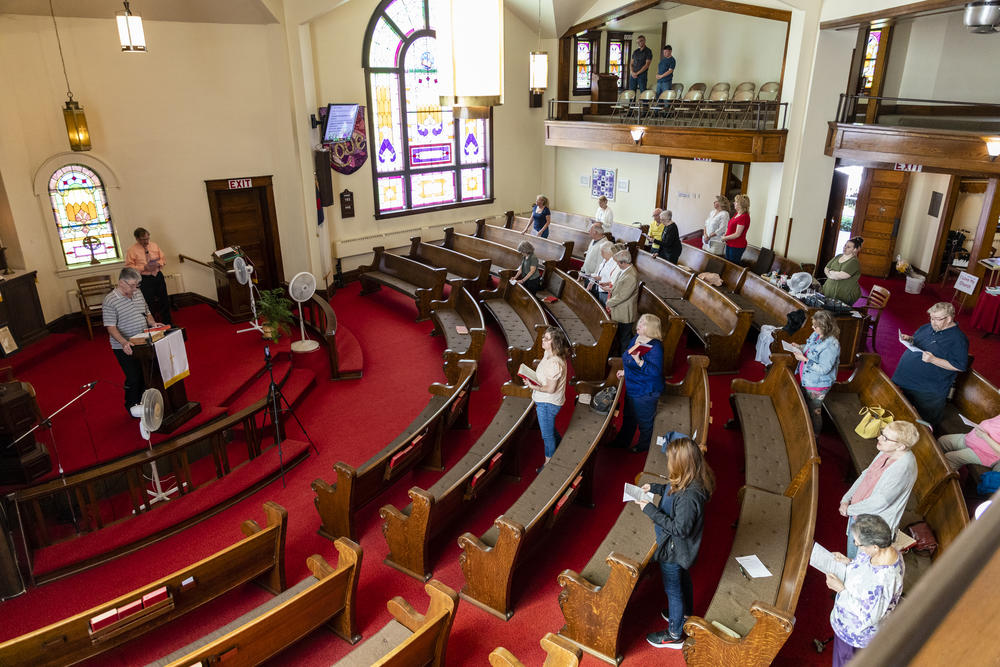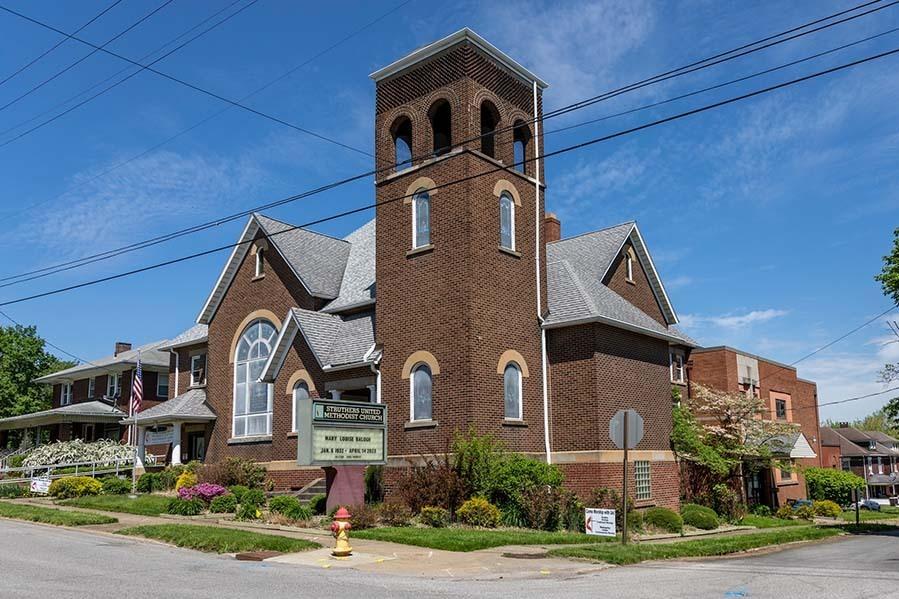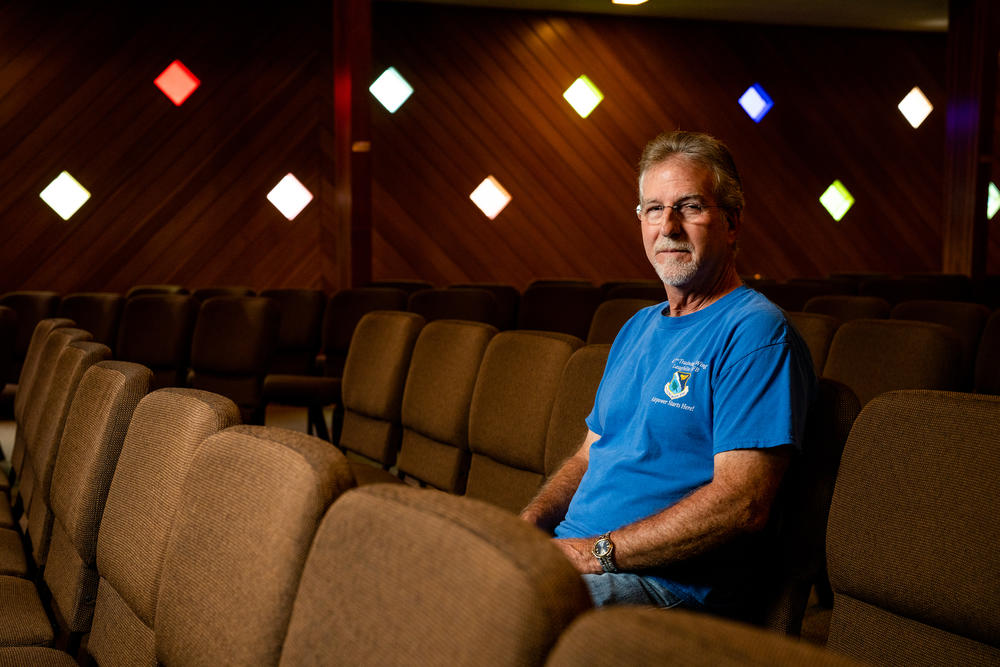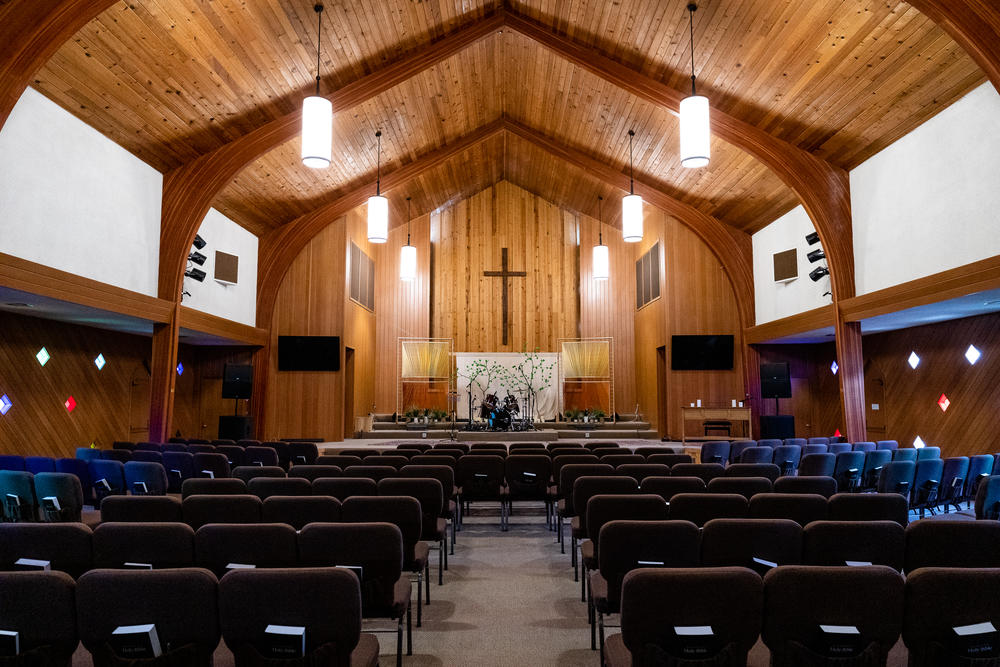Loading...
Section Branding
Header Content
The faithful see both crisis and opportunity as churches close across the country
Primary Content
When Pastor Douglas Theobald steps to the pulpit at Struthers United Methodist Church this Sunday, it will likely be the last religious service in its 112-year history.
Over the years, Struthers UMC has weathered the boom and bust cycles of the Youngstown, Ohio, suburb. In the 1960s, when the steel industry was at its height, it was common to see as many as 250 people in the pews on any given Sunday. But Theobald, who started preaching there in 2009, has presided over a congregation in slow decline. Today, services attract only a few dozen, mostly older, congregants.
"We're a small church," he acknowledges. "We're never going to be hundreds of people in attendance."
Last fall, the United Methodist Church office overseeing the congregation said Struthers had fallen behind in the money it pays for denominational support. It determined that the church was no longer a "vital congregation" and would have to close.
The situation is hardly unique, nor is it confined to the United Methodist Church, a denomination that has undergone a recent split over the issue of LGBTQ+ inclusiveness. Just 16% of Americans say religion is the most important thing in their life, according to a new report released this week by the Public Religion Research Institute. A 2020 survey found that the average congregation size across Christian denominations is less than half what it was in 2000 — down to 65 from 137. It also found that on average, a third of churchgoers are 65 or older, twice that age group's representation in the general population. These numbers held true for Protestants, Evangelicals and Catholics alike. Only congregations of other faith traditions — including Islam, Baha'i and Judaism — are seeing increases, the survey said.
The sharp uptick in the number of younger Americans with no religious affiliation — a group known as the "nones" — is the major driver in a seismic shift in the religious landscape, says Ryan Burge, a political science professor at Eastern Illinois University and author of The Nones: Where They Came From, Who They Are, and Where They Are Going.
"Boomers are about 20% 'nones' and Gen Z is about 45% 'nones,' so you're just seeing this kind of slow wave sweep across America," says Burge, who is himself a pastor with the American Baptist Church. He believes about a third of the country's 350,000 Christian congregations are "on the brink of extinction."
"Every year the pews are getting emptier and the collection plates getting lighter," he says. "We're going to see thousands of churches closing in America over the next 20 or 30 years in every part of the country, in every region and every state, urban, suburban, rural."
Waiting for a miracle
In Struthers, Theobald and his parishioners are caught up in that sea change. Not only are they anguished about the decision to close their church, they are angry. The congregation voted overwhelmingly to stay open but was overruled, they say.
Sherry Noble, the church's administrative board chairperson, was raised in the church, baptized and married there. "It just has been so disheartening," she says, choking up. "I can't imagine never going there again."
Noble says the church was struggling to meet its obligations to the denomination, but "we were still continuing and supporting the missions of our church."
"I'm hopeful for a miracle," she says. "I'm hopeful that someway, somehow that we'll be able to [continue] as a congregation."
Closings can mean the loss of critical services
The shift away from religion occurring in the U.S. mirrors what happened decades ago in post-World War II Europe, says Bob Smietana, a reporter for Religion News Service. He worries about how the U.S. will cope with the sudden evaporation of community services that churches once provided — food banks, help for troubled teens, addiction treatment and other programs.
"Most European countries have very strong social safety net systems in place and the U.S. doesn't," he notes. "So, when those services disappear, there really isn't anything to replace them."
Corpus Christi Catholic Church in the Bronzeville area of Chicago is an example of what happens to those community services when a church falls into decline. The church, like many Catholic institutions, ran a soup kitchen for years. It also once operated a thriving school. Both are now gone. The church itself closed in 2021. Its congregation merged with three other parishes to form Our Lady of Africa parish.
Father Edmund Nnadozie, who oversaw the merger and the closing of Corpus Christi, says the church skewed older. "The numbers had gone down," he acknowledges. However, there were some younger faithful, just not nearly enough, he says.
Now working as a parochial administrator outside Las Vegas, Nnadozie remembers his final Mass in Chicago two years ago. Unlike a normal Sunday, people showed up in numbers. "You're talking about people who have been through the parish over a period of years. It was very nostalgic," he says.
Before the church closed, its members began meeting over Zoom with others who would soon be part of the new, merged parish. "People got to know each other," making for a smoother transition, Nnadozie says.
As for the church itself, built in 1915, the imposing Renaissance Revival-style stone structure along with a rectory and the school stand vacant and for sale, a local real estate agent confirmed. The asking price is $1.7 million.
Selling churches can be a boom or bust proposition
That question of what to do with vacated churches has become an increasingly complex problem in recent years amid mergers and downsizing. Many churches, like the one in Struthers, were built more than a century ago to support much larger congregations, says Richard Reinhard, principal consultant at Niagara Consulting Group, which focuses on church reuse and redevelopment.
"There's a huge mismatch between small congregations and large properties," he says. "Their real estate becomes too big and too expensive for them."
"In New York, San Francisco, Miami, developers are chomping at the bit to come in and get their hands on urban church properties and to turn them into luxury condos or ... offices," Reinhard says. However, "in poorer communities and in rural communities, often churches just sit there and nothing happens to them."
As congregations wind down, they're not always planning for the future, says Dominic Dutra, a Fremont, Calif.-based real estate consultant who specializes in "reimagining church spaces." Although Christian theology is "grounded in death and resurrection," most troubled churches have difficulty accepting reality until it's too late, he says.
The churches, Dutra says, "are not ours, they're God's. [We should] use them in a way to bless these communities."
"The end of the congregation is not a bad thing," he says. "It can be an opportunity for new life and to take joy in that."
"We knew it was going to happen"
One church taking that message to heart is the First Christian Church in Bartlesville, Okla. It's an imposing 125-year-old Roman Gothic structure in the heart of the city located about an hour north of Tulsa.
In 2018, Susan Payne arrived there as a transitional minister. She says two things stood out during her first visit to the 36,000-square-foot building. One was a 100-year-old photograph labeled "Sunday School" that showed perhaps a thousand people at the church, she says. The other was when she asked to see the baptistery.
"They said, 'Oh, well, it's this way. But we can't use it. It doesn't drain,'" Payne recalls. "For a church that baptizes by immersion not to have a working baptistery and not to be very upset about it, that to me was kind of a metaphor for where the congregation was at that point."
The church that once drew hundreds had dwindled to about 30 people for Sunday services by the time Payne arrived. It had already tried and failed to merge with other congregations.
Payne says the church still had about $1 million to draw on, and donations were fairly steady. However, after the congregation looked carefully at the financial situation, "they realized that [the money] ... wasn't being used for ministry and mission. It was being used to support a building."
It was clear that staying open no longer made economic sense, she says. With some sadness, the congregation unanimously decided to close the doors; its last Sunday service was held in April of last year.
Many church leaders say that the COVID-19 pandemic was an added blow, simply amplifying an already well-established trend toward shrinking attendance. But Payne says, "COVID actually gave us the space to take a pause and use that time constructively to make these decisions."
For Sharon Armstrong and others in the close-knit congregation, the choice to close came as something of a relief. "We knew it was going to happen sometime or other."
"Our congregation had gotten very elderly, I guess you would say," she says. Armstrong, 81, was a member of the Bartlesville church for more than three decades. She taught Sunday school, was treasurer of the Christian Women's Fellowship, and for the last many years, headed the church board.
In the aftermath of the closure, she and her husband, Ken, began visiting other churches and watching services online. They think they may have found a church that works for them.
But before the Bartlesville church itself could be repurposed, its sacred belongings needed to find new homes. Payne says, "We had to go out to our other congregations in the community and also in the state and say, 'What do we have that you could use?'"
A church in Texas received a communion chalice. Other congregations got communion wear and offering plates. The building was handed over to the city of Bartlesville, which has been trying to decide what to do next. One proposal under serious consideration is from a company that wants to convert the church into a film studio, Armstrong says. "To me, it sounds like a wonderful way to use our building. And they're not going to change the outside at all."
Adapting to the needs of the community
In Santa Cruz, Calif., the Church of the Nazarene had long served its community but was closed two years ago. By then, Dave Beasley, a member of the congregation for 35 years, was one of only 20 or so people still regularly attending Sunday services.
"I was one of the younger ones and I was in my early 60s at the time. Many were in their 70s and 80s," Beasley says.
The church, which has a long legacy of ministry to the poor, "didn't really have the critical mass or the volunteer base to sustain any kind of meaningful engagement with the community," according to Beasley.
It was already renting space to the nondenominational Faith Community Church of Santa Cruz, so a former pastor reached out to the tenants to "help us reimagine that facility as an asset to the community," says the Rev. Albert Hung, superintendent for the Church of the Nazarene's Northern California District. What they've agreed on is a community space for nonprofits.
Faith Community Church "is doing the heavy lifting," Hung says. "We are asking them to take care of the property and steward the property, find community renters and nonprofits."
"In the long run, we hope that by creating positive relationships with the city and with our neighbors there, that maybe at some point we can start another Nazarene congregation," he says.
The ability to adapt to the changing demographics and needs in a community is key to survival in the current, increasingly challenging environment for churches, says Payne, the transitional minister from Bartlesville.
She has found a vibrant congregation to lead in the town of Enid, Okla., and was thrilled to find out that the church is still supporting outreach and hunger ministries.
"I just think it's really important that the congregations make sure that their ministry is connected to the community ... and [adapts] as that community changes," she says.
"When you find you're disconnected from your community, that's never a good thing."
Copyright 2023 NPR. To see more, visit https://www.npr.org.
